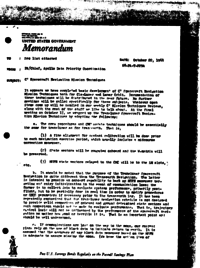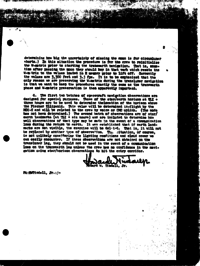See list attachedOctober 22, 196868-PA-T-229APA/Chief, Apollo Data Priority CoordinationC’ Spacecraft Navigation Mission Techniques
It appears we have completed basic development of C' Spacecraft Navigation Mission Techniques both for Cis-Lunar and Lunar Orbit. Documentation of these techniques will be distributed in the near future. No further meetings will be called specifically for their subjects. Whatever open items come up will be handled in our weekly C' Mission Techniques Reviews, along with the rest of the stuff we life to talk about. At the final meeting on October 17, we wrapped up the Translunar Spacecraft Naviga- tion Mission Techniques by adopting the following:
a. The crew procedures and CMC update techniques should be essentially the same for translunar as for transearth. That is,
(1) A fine alignment for sextant calibration will be done prior to each navigation exercise period, which usually includes a midcourse correction maneuver.
(2) State vectors will be computed onboard and the W-matrix will be preserved.
(3) MSFN state vectors relayed to the CMS will be to the LM slots, etc.
b. It should be noted that the purpose of the Translunar Spacecraft Navigation is quite different than the Transearth Navigation. The latter is intended to provide an onboard capability to back up MSFN maneuver tar- geting and entry initialization in the event of communication loss; the former is to collect data to evaluate systems performance, primarily post- flight, but to be partially done in real time in order to modify procedures or GNCS parameters if necessary prior to the transearth leg. It has been repeatedly emphasized that the translunar navigation schedule is not designed to provide valid comparison of onboard and ground determined state vectors and such comparison should not be made to evaluate performance. That is, trajectory control logic will not be influenced by the performance of the spacecraft navi- gation no matter how good or terrible it is. That is an important point and should be well understood.
c. If communications are lost on the way to the moon, our current plans rely on the use of block data to initiate return to earth. It is assumed that the accuracy of any block data maneuver based on the MSFN is adequate to assure missing the moon. (We have the action item of determining how big the uncertainty of missing the moon is for circumlunar aborts.) In this situation the procedure is for the crew to reinitialize the W-matrix prior to starting the transearth navigation. That is, some- time after passing the moon they should key in that verb which resets the W-matrix to the values loaded in E memory prior to lift off. Currently the values are 3,300 feet and 3.3 fps. It is to be emphasized that the only reason we ere preserving the W-matrix during the translunar navigation is that we want to keep the procedures exactly the same as the transearth phase and W-matrix preservation is then apparently important.
d. The first two batches of spacecraft navigation observations are designed for special purposes. Those of the star/earth horizon at ILI + three hours are to be used to determine the location of the horizon above the Fischer Ellipsoid. This value will be determined in-flight by the MCC-H and will be related to the crew by voice or CMC uplink. (The mode has not been determined.) The second batch of observations are of star/ earth landmarks (at TLI + six hours) and are included to determine how well observations of that type may be made in the event of communication loss during the return to earth. It was established that if earth land- marks are not visible, the exercise will be deleted. That is, it will not be replaced by another type of observation. This situation, of course, is not unlikely considering the lighting conditions and cloud cover we can easily encounter. If these observations are not obtained on the translunar leg, they should not be used in the event of a communication loss on the transearth leg unless the crew has no confidence in the navi- gation using star/horizon observations to hit the entry corridor.
- Jan 14, 1969 – Operations required for communication loss on F and G are sure better than on C’ (4.4σ)
- Sep 25, 1968 – C’ Communication Loss (4.3σ)
- Oct 17, 1968 – Transearth Spacecraft Navigation (4.1σ)


